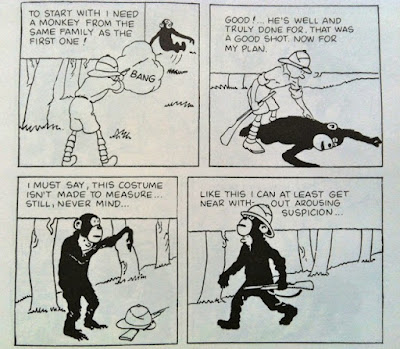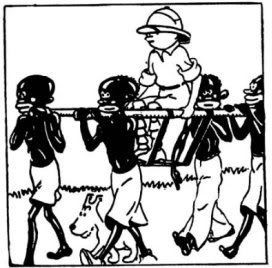Ou Aller ? Where to go?
 |
| Le Petit Vigntieme 22-May-1931 Ou Aller ? |
The serialisation of Tin Tin in the Land of the Soviets ended in the 8th May edition of Le Petit Vingtième. The cover of the 22nd May shows Tin Tin and Milou looking at a globe and pondering Ou Aller ? Where to go ?
A week later Tin Tin's and Milou's destination was revealed - the Congo.
 |
| Le Petit Vigntieme 29-May-1931 Tin Tin et Milou au Congo |
However...... my box collection does not contain Tin Tin in the Congo.
Tin in the Congo was serialised in Le Petit Vingtième from 5th June 1930 to 19th June 1931. The album was published in 1931.
The concept behind the story was to educate Belgian children about the Belgian Colony of the Congo. To those in Belgium it was considered that the Congo was full of happy natives who supported colonial rule.
The portrayal of the Congolese people in the adventure is not flattering and and are very much represented as an underclass.
The portrayals reflected the catholic, conservative, and imperialistic views of the Belgian middle class in the 1920's / 1930's. Views consistent with the pro fascist priest editor of the catholic conservative newspaper Le Vingtième Siècle, Norbert Wallez, who had asked Hergé to create Le Petit Vingtième in 1928.
One part of the adventure shows Tin Tin teaching class of Congolese children. He tells the pupils "My dear friends, today I'm going to talk to you about your fatherland: Belgium!". A paternalistic attitude that the European Colonials were there to help and guide the natives.
The reality had been that during the latter part of the 19th century the Belgian colonial rule in the Congo had been particularly brutal.
The scenes portraying the Congolese people and the attitudes towards them, especially comments from Snowy are disturbing......
..... Tin Tins faithful companion in the Congo, Coco, is thought by Snowy that "he doesn't look very bright."......
.... a grovelling native extolling the virtues of the white man and Snowy proclaiming "we're the tops."
....and Tin Tin borne by native bearers.
Another disparaging scene is when a train is derailed when it collides with Tin Tin's car. The natives are depicted as being lazy and workshy, with Tin Tin berating them for their lack of effort.
 |
| Tin Tin berating natives for their lack of effort |
A lack of respect for wildlife is another feature of the adventure.There is a scene of Tin Tin hunting elephant and removing their tusks. A particularly uncomfortable scene given the problem in Africa with ivory poaching endangering the Elephant population.
Another endangered species is killed by Tin Tin when he blows up a rhinoceros.
There is also a disturbing scene where Tin Tin shoots a monkey, skins it, and wears the pelt as a disguise.
 |
| Tin Tin kills and skins a monkey to make a disguise |
Hunting was a popular pastime in colonial times. A pastime now regarded as not acceptable with the focus being wildlife conservation.
The racist depictions and stereotyping of the Congolese in a derogatory manner is extremely uncomfortable. The scenes of hunting endangered species and animal cruelty are unsettling.
It is therefore not surprising that Tin Tin the Congo is not included in the box set.
The viewpoints expressed reflect todays feelings about those from other nations and animal conservation. The adventure was published in 1930 l 1931 and attitudes have changed significantly. As Hergé said of his earliest work;
The album was redrawn in colour in 1946 and the colonial aspects toned down.
For example the scene in which Tin Tin instructs pupils at a missionary school. In the 1931 edition Tin Tin is telling the children about the Fatherland. Belgium. In the 1946 version re-drawn in colour, the scene was changed to a to a mathematics lesson.
Even the re-drawn version has it's uncomfortable scenes. One shows Tin Tin asking "for the third time of asking, two plus two makes...what?" which gives a sense that the Congolese children are uneducated.
Whilst Tin Tin in the Congo is not in my Tin Tin box set, it is available as a collectors edition. It was published in English for the first time in 2007. A red band records "Collector's Edition.... This colour edition completes the series of 24 Tintin adventures by Hergé".
The red bad further records; Tin Tin au Congo was first published in book form in French in 1931.
"In his portrayal of the Belgian Congo, the young Hergé reflects the colonial attitudes of the time ...he depicted the African people according to the bourgeois, paternal stereotypes of the period-an interpretation that some of today's readers may find offensive."
The foreword to the edition adds "The same could be said about big game hunting".















